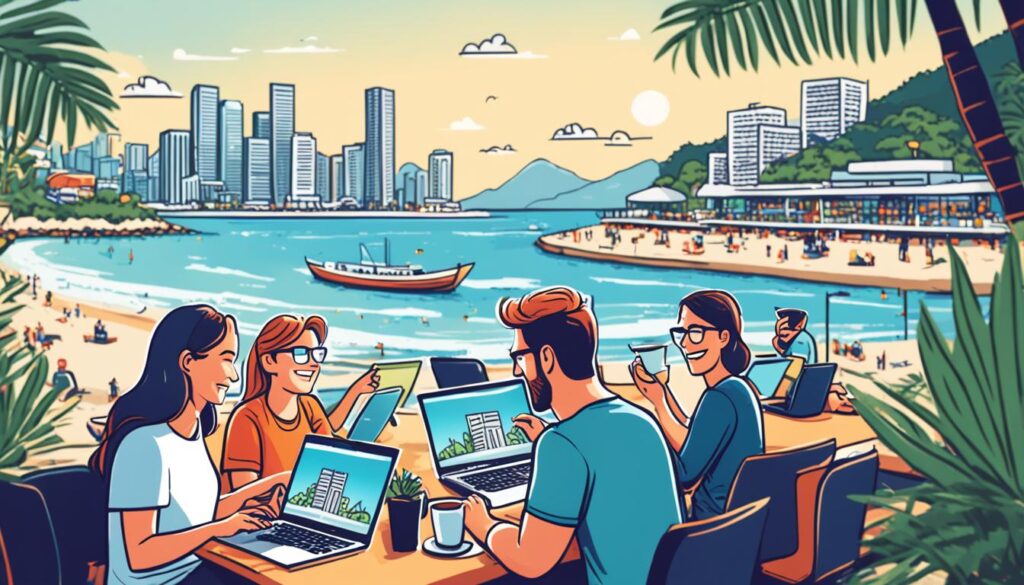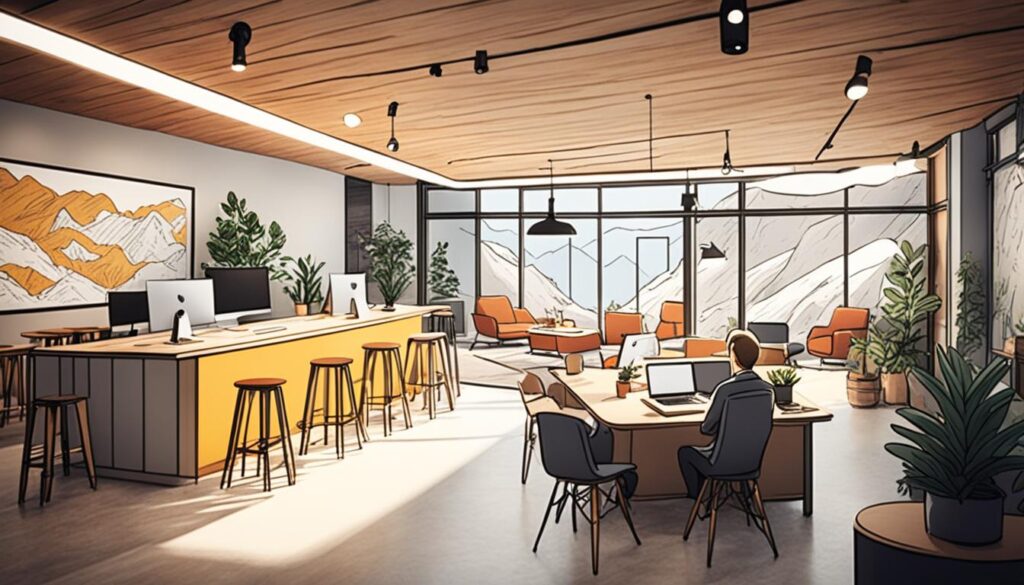Ultimate Guide: Digital Nomads in Busan, Korea

Busan, South Korea has become a prime destination for digital nomads seeking a vibrant city with a unique blend of modern urban living and breathtaking natural beauty. This ultimate guide will provide all the essential information for digital nomads in Busan, including coworking spaces, accommodation options, transportation, and the best ways to unwind in this bustling city.
For digital nomads, finding the right coworking space is crucial, and Busan offers a variety of options to cater to different working styles and needs. Whether you prefer a productive environment with social interactions or a budget-friendly space with 24-hour access, Busan has got you covered.
When it comes to living in Busan, there are several neighborhoods to consider, each with its own unique charm and offerings. From the entertainment hub of Haeundae to the authentic beauty of Nampo-Dong, digital nomads can choose a neighborhood that aligns with their preferences and lifestyle.
In terms of transportation, Busan boasts a well-connected subway system, making it easy to navigate the city and explore its many attractions. Buses and taxis are also available for those who prefer alternative options.
Speaking of attractions, Busan has plenty to offer digital nomads looking to immerse themselves in the local culture. From the famous Haeundae Beach and Gamcheon Culture Village to the serene Haedong Yonggungsa Temple and bustling Jagalchi Market, there are endless opportunities to explore and unwind in this vibrant city.
And let’s not forget about the local cuisine! Busan is renowned for its delicious seafood, and a visit to the Jagalchi fish market is a must for every digital nomad. Don’t miss the chance to indulge in local delicacies like milmyeon and dwaeji gukbap.
So whether you’re looking for a stimulating coworking space, a comfortable place to live, exciting attractions to visit, or mouthwatering seafood to savor, Busan has it all. Join us as we delve into the ultimate guide for digital nomads in Busan, Korea.
Best Places to Live in Busan
When it comes to finding the best place to live in Busan as a digital nomad, you have a few options to consider. Each neighborhood in Busan offers its own unique charm and advantages, catering to different preferences and needs.
Haeundae
If you’re looking for a lively neighborhood with plenty of entertainment and shopping options, Haeundae is the place to be. Haeundae is famous for its beautiful beach, vibrant nightlife, and high-end resorts. However, keep in mind that living in Haeundae can be quite expensive.
Seomyeon
For digital nomads who prefer the convenience of a downtown area, Seomyeon is an excellent choice. Seomyeon serves as the city’s main commercial district, offering a wide range of facilities, including shopping malls, restaurants, and cafes. It’s also well-connected to public transportation, making it easy to explore other parts of Busan.
Nampo-Dong
If you want to experience Busan’s authenticity and beauty, Nampo-Dong is the neighborhood for you. This area is known for its vibrant street markets, traditional food stalls, and historical landmarks. Living in Nampo-Dong allows you to immerse yourself in the local culture and enjoy the charming streets lined with shops and cafes.
Ultimately, the best place for you to live in Busan depends on your lifestyle preferences and budget. Whether you choose Haeundae for its entertainment, Seomyeon for its convenience, or Nampo-Dong for its authenticity, Busan has something to offer every digital nomad.
Top Coworking Spaces in Busan
Busan is a haven for digital nomads, providing a range of coworking spaces where remote workers can thrive and collaborate. If you’re looking for the perfect place to work and connect with like-minded individuals, here are two of the top coworking spaces in Busan:
The Cave Busan

The Cave Busan is a highly productive coworking space that offers a conducive environment for getting work done. Located in the heart of Busan, this space provides a variety of amenities to enhance your work experience, including high-speed internet, comfortable seating, and private meeting rooms.
At The Cave Busan, you’ll also find a strong emphasis on social interactions. The community events and networking opportunities allow digital nomads to meet new people and make valuable connections.
Pathfinder
Pathfinder is another popular choice for digital nomads in Busan. Conveniently situated between Choryang Station and Busanjin Station, this coworking space offers easy accessibility and flexible working hours with 24-hour access.
With its affordable prices and comfortable workspaces, Pathfinder caters to the needs of remote workers seeking a productive and collaborative environment.
Whether you prefer a space that fosters social interactions or one that provides flexibility, these coworking spaces in Busan have everything you need to work efficiently and connect with a vibrant community of digital nomads.
| Coworking Space | Location | Amenities | Opening Hours |
|---|---|---|---|
| The Cave Busan | Central Busan | High-speed internet, comfortable seating, private meeting rooms | 8:00am – 9:00pm |
| Pathfinder | Between Choryang Station and Busanjin Station | Flexible working hours, comfortable workspaces | 24-hour access |
Getting Around Busan
Exploring the vibrant city of Busan is a breeze with its efficient transportation system. Whether you prefer the convenience of the subway, the flexibility of buses, or the ease of taxis, there are several options to help you get around.
Metropolitan Subway System
The Metropolitan Subway System is the primary mode of transportation in Busan, connecting the city’s major attractions and neighborhoods. With an extensive network of lines, it provides convenient access to various parts of Busan. Whether you’re heading to Haeundae Beach, exploring Seomyeon’s bustling streets, or visiting the picturesque Gamcheon Culture Village, the subway is a reliable and efficient way to travel.
To make the most of your subway journeys, it is advisable to purchase a T-Money Card. This rechargeable card can be used for tap-to-pay in all modes of transportation, including the subway, buses, and taxis. Additionally, the T-Money Card offers discounts on several purchases at convenience stores and even attractions, making it a valuable asset for digital nomads in Busan.
Buses
While the subway is the most popular mode of transportation, Busan also has an extensive bus network. Buses are a great option for reaching destinations that may not be covered by the subway or for exploring areas further afield. However, it’s worth noting that buses in Busan may not be as frequent as in Seoul, so it’s advisable to plan your journey in advance and check the schedules.
Taxis
Taxis in Busan provide a convenient and hassle-free option, especially for those who prefer not to rely on the bus system or prefer the convenience of door-to-door service. Taxis are readily available throughout the city and can be hailed on the street or found at taxi stands. Just be sure to have the address or destination written in Korean or show it on a map to ensure clear communication with the driver.
Whether you choose to travel by subway, bus, or taxi, getting around Busan is a breeze. With a reliable transportation system, you can easily navigate the city and explore all that Busan has to offer.
“Busan’s transportation system is so convenient, whether you’re a digital nomad or a tourist. The subway connects all the major attractions, and the buses and taxis provide additional flexibility. It’s easy to get around and make the most of your time in this vibrant city.” – Digital Nomad, Busan
Explore the convenient transportation options in Busan and make the most of your time in this vibrant city.
| Transportation Mode | Pros | Cons |
|---|---|---|
| Subway | Convenient access to various parts of the city Efficient and reliable T-Money Card provides discounts on purchases |
May be crowded during peak hours |
| Buses | Extensive network covering various areas Flexibility in reaching destinations |
Less frequent compared to the subway |
| Taxis | Door-to-door service Convenient for those unfamiliar with the city Readily available |
Slightly more expensive than other transportation options |
Choosing the right mode of transportation in Busan depends on your preferences and needs. Consider the pros and cons of each option to make the best choice for your travels.
Best Time to Visit Busan
When planning a trip to Busan, it’s essential to consider the best time to visit to make the most of your experience in this vibrant city. The seasons in Busan offer different flavors, each with its own unique attractions and weather conditions.
Spring (April to June) is a delightful time to visit Busan, as the city comes alive with beautiful cherry blossoms and a burst of color from blooming flowers. The weather during this season is mild, with temperatures ranging from 15°C to 25°C (59°F to 77°F). It’s perfect for exploring outdoor attractions, taking leisurely walks along the beach, and enjoying cultural festivals.
Autumn (September to November) is another fantastic time to experience Busan’s natural beauty. The weather remains pleasant, with temperatures ranging from 10°C to 22°C (50°F to 72°F). The autumn foliage offers stunning landscapes, and it’s a great time to hike in the surrounding mountains, visit parks, and enjoy outdoor activities.
While spring and autumn are considered the best seasons to visit Busan, the city has something to offer even during the summer and winter seasons. Summer (July to August) brings warm temperatures that can reach up to 35°C (95°F). It’s the best time to enjoy Busan’s famous beaches, such as Haeundae and Gwangalli. The city is bustling with beachgoers, summer festivals, and exciting water sports activities.
Winter (December to February) brings colder weather, with temperatures ranging from -5°C to 10°C (23°F to 50°F). While it may not be the ideal time for beach activities, winter offers its own charm in Busan. The city transforms into a winter wonderland, and you can experience snowy landscapes, festive markets, and warm up with delicious hot soups and stews.
Ultimately, the best time to visit Busan depends on your preferences and planned activities. Whether you’re seeking warm weather, vibrant festivals, cherry blossoms, or winter magic, Busan is a city that can be enjoyed year-round.
| Season | Temperature Range | Main Attractions |
|---|---|---|
| Spring (April to June) | 15°C to 25°C (59°F to 77°F) | Cherry blossoms, blooming flowers, outdoor festivals |
| Summer (July to August) | Up to 35°C (95°F) | Beach activities, summer festivals, water sports |
| Autumn (September to November) | 10°C to 22°C (50°F to 72°F) | Fall foliage, hiking, parks, outdoor activities |
| Winter (December to February) | -5°C to 10°C (23°F to 50°F) | Snowy landscapes, winter markets, cozy food |
Table: Best Time to Visit Busan – Seasonal Highlights
Must-Visit Attractions in Busan
When visiting Busan, digital nomads have a plethora of must-visit attractions to explore. From picturesque beaches to cultural landmarks, the city offers a diverse range of experiences. Here are some of the top attractions that should be on every digital nomad’s itinerary:
Haeundae Beach

Haeundae Beach is a world-renowned beach destination and one of Busan’s most popular attractions. With its crystal-clear waters and soft sands, it provides the perfect location for digital nomads to unwind and soak up the sun. Additionally, there are numerous beachside cafes and restaurants where visitors can enjoy delicious local cuisine while enjoying the breathtaking coastal views.
Gamcheon Culture Village
The Gamcheon Culture Village is a vibrant and colorful neighborhood known for its artistic and cultural marvels. Digital nomads can explore the narrow alleyways adorned with vibrant murals, art installations, and sculptures. The village also houses numerous art galleries, cafes, and boutique shops. It’s a truly unique and Instagram-worthy destination that offers a glimpse into Busan’s creative spirit.
Haedong Yonggungsa Temple
For those seeking a peaceful and spiritual experience, the Haedong Yonggungsa Temple is a must-visit attraction in Busan. Situated along the coastline, this beautiful Buddhist temple offers stunning ocean views and a serene ambiance. Digital nomads can explore the temple’s intricate architecture, statues, and pagodas while enjoying the tranquility of the surroundings. It’s a perfect spot for reflection and meditation.
Jagalchi Market
“The bustling atmosphere of Jagalchi Market is an experience like no other. With its vibrant seafood stalls and lively atmosphere, it’s a must-visit for digital nomads looking to immerse themselves in Busan’s bustling food culture.”
Located in Busan’s Nampo-Dong district, Jagalchi Market is the largest seafood market in South Korea. Digital nomads can wander through the bustling stalls filled with an abundance of fresh seafood, including fish, clams, and octopus. Visitors can also dine at the market’s numerous seafood restaurants, where they can indulge in fresh and delicious dishes. It’s a sensory delight that showcases the heart and soul of Busan’s culinary scene.
Visiting these must-visit attractions in Busan allows digital nomads to experience the unique charm and beauty of the city. From relaxing on Haeundae Beach to immersing in the vibrant atmosphere of Jagalchi Market, each attraction offers a different aspect of Busan’s rich culture and natural wonders.
Local Cuisine and Dining in Busan
Busan, the coastal city of South Korea, is renowned for its exceptional local cuisine and diverse dining options. Exploring the vibrant culinary scene is a must for digital nomads looking to immerse themselves in Busan culture and indulge in savory delights.
The centerpiece of Busan’s culinary offerings is undoubtedly its fresh seafood. For a truly authentic experience, a visit to the iconic Jagalchi fish market is essential. Located on the shores of the city, this bustling market offers a captivating glimpse into the local fishing industry, with a vast array of seafood on display.
At Jagalchi fish market, digital nomads can savor a wide selection of fish, shellfish, and other underwater delicacies. From sashimi to grilled seafood dishes, there’s something to satisfy every seafood lover’s palate.
Aside from seafood, Busan boasts a range of culinary delights that showcase its unique flavors. One must-try dish is milmyeon, a spicy cold noodle soup that combines chewy noodles with a piquant broth, topped with pickled radish and vegetables. The combination of textures and bold flavors makes milmyeon a refreshing and satisfying choice, especially during the warmer months.
Another local favorite is dwaeji gukbap, a hearty pork soup served with a side of rice. This comforting dish is perfect for colder days and provides a balance of rich flavors and tender meat.
Busan’s dining scene extends beyond traditional Korean cuisine, offering a diverse range of international flavors. From trendy cafes to fine dining establishments, digital nomads can explore various cuisines and find their preferred dining spots.
Whether you’re craving traditional Korean delicacies, a seafood feast at Jagalchi fish market, or international cuisine, Busan offers a culinary adventure that will captivate your taste buds.
Top Local Dishes in Busan
Here are some of the must-try local dishes in Busan:
- Milmyeon: Spicy cold noodle soup
- Dwaeji gukbap: Pork soup with rice
- Sashimi: Fresh raw seafood
- Haemul pajeon: Seafood pancake
- Bibimbap: Mixed rice with vegetables and meat
- Gukbap: Rice soup with various toppings
Recommended Restaurants in Busan
Here are some highly recommended restaurants in Busan:
- Restoran A: Specializes in authentic Korean cuisine, including seafood dishes.
- Restoran B: Offers a fusion of Korean and international flavors, with an emphasis on locally sourced ingredients.
- Restoran C: Known for its seafood hotpot and grilled dishes, providing a memorable dining experience.
- Restoran D: A cozy cafe that serves homemade pastries and beverages, perfect for a relaxing break.
Busan’s Culinary Delights
“The vibrant culinary scene of Busan showcases the city’s rich coastal heritage and diverse flavors. From fresh seafood at Jagalchi fish market to authentic local dishes like milmyeon and dwaeji gukbap, Busan offers a feast for the senses. Exploring the city’s dining options is an essential part of experiencing the unique charm of Busan.”
Conclusion
Busan, South Korea is the perfect destination for digital nomads seeking a harmonious blend of modern amenities, cultural richness, and the wonders of nature. This vibrant city offers a plethora of resources to support the digital nomad lifestyle, including coworking spaces, a wide range of living options, and a dynamic urban landscape. With its diverse attractions, delectable cuisine, and picturesque beaches, Busan has something to captivate every digital nomad’s heart.
For those seeking a productive work environment, Busan’s coworking spaces like The Cave Busan and Pathfinder provide optimal settings for remote work and networking opportunities. The availability of reliable transportation options, such as the Metropolitan Subway System and taxis, ensures convenient mobility across the city.
When it’s time to unwind, digital nomads can immerse themselves in the beauty of Busan. From the golden sands of Haeundae Beach to the fascinating Gamcheon Culture Village and the serene Haedong Yonggungsa Temple, Busan’s attractions offer a wealth of unique experiences. Indulging in the local cuisine, particularly the mouthwatering seafood at the legendary Jagalchi fish market, is a must-do for any food enthusiast.
In conclusion, Busan, South Korea caters to the diverse needs of digital nomads, providing an enriching environment for work, leisure, and exploration. Whether you are drawn to the bustling city life, the breathtaking landscapes, or the authentic local culture, Busan invites digital nomads to embark on an unforgettable journey in this remarkable South Korean gem.